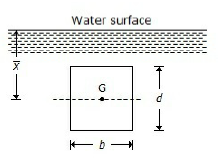Liquids
Cannot be compressed
Occupy definite volume
Are not affected by change in pressure and temperature
None of the above
Correct Answer :
D. None of the above
Related Questions
Rotameter is a device used to measure
Absolute pressure
Velocity of fluid
Flow
Rotation
The conditions for the stable equilibrium of a floating body are
The metacentre should lie above the center of gravity
The center of buoyancy and the center of gravity must lie on the same vertical line
A righting couple should be formed
All the above are correct
When the Mach number is more than 6, the flow is called
Sub-sonic flow
Sonic flow
Super-sonic flow
Hyper-sonic flow
Choose the wrong statement
Fluids are capable of flowing
Fluids conform to the shape of the containing vessels
When in equilibrium, fluids cannot sustain tangential forces
When in equilibrium, fluids can sustain shear forces
In a venturi-flume, the flow takes place at
Atmospheric pressure
Gauge pressure
Absolute pressure
None of these
The pressure less than atmospheric pressure is known as
Suction pressure
Vacuum pressure
Negative gauge pressure
All of these
Newton's law of viscosity is a relationship between
Shear stress and the rate of angular distortion
Shear stress and viscosity
Shear stress, velocity and viscosity
Pressure, velocity and viscosity
One stoke is equal to
10-2 m2/s
10-3 m2/s
10-4 m2/s
10-6 m2/s
The property by virtue of which a liquid opposes relative motion between its different layers is called
Surface tension
Coefficient of viscosity
Viscosity
Osmosis
Fluid is a substance which offers no resistance to change of
Pressure
Flow
Shape
Volume
Kinematic viscosity is dependent upon
Pressure
Distance
Density
Flow
The discharge in an open channel corresponding to critical depth is
Zero
Minimum
Maximum
None of these
A fluid whose viscosity does not change with the rate of deformation or shear strain is known as
Real fluid
Ideal fluid
Newtonian fluid
Non-Newtonian fluid
If the depth of water in an open channel is greater than the critical depth, the flow is called
Critical flow
Turbulent flow
Tranquil flow
Torrential flow
The loss of pressure head in case of laminar flow is proportional to
Velocity
(Velocity)2
(Velocity)3
(Velocity)4
The value of bulk modulus of a fluid is required to determine
Reynold's number
Froude's number
Mach number
Euler's number
A vertically immersed surface is shown in the below figure. The distance of its centre of pressure from the water surface is 
(bd²/12) + x
(d²/12 x) + x
b²/12 + x
d²/12 + x
Capillary action is due to the
Surface tension
Cohesion of the liquid
Adhesion of the liquid molecules and the molecules on the surface of a solid
All of the above
A flow whose streamline is represented by a curve, is called
One-dimensional flow
Two-dimensional flow
Three-dimensional flow
Four-dimensional flow
According to Bernoulli's equation for steady ideal fluid flow
Principle of conservation of mass holds
Velocity and pressure are inversely proportional
Total energy is constant throughout
The energy is constant along a streamline but may vary across streamlines
The increase in pressure at the outer edge of a drum of radius (r) completely filled up with liquid of density (ρ) and rotating at (ω) rad/s is
ρ ω2 r2
2ρ ω2 r2
ρ ω2 r2/2
ρ ω2 r2/4
Coefficient of contraction is the ratio of
Actual velocity of jet at vena contracta to the theoretical velocity
Loss of head in the orifice to the head of water available at the exit of the orifice
Loss of head in the orifice to the head of water available at the exit of the orifice
Area of jet at vena-contracta to the area of orifice
Barometer is used to measure
Velocity of liquid
Atmospheric pressure
Pressure in pipes and channels
Difference of pressure between two points in a pipe
An open vessel of water is accelerated up an inclined plane. The free water surface will
Be horizontal
Make an angle in direction of inclination of inclined plane
Make an angle in opposite direction to inclination of inclined plane
Any one of above is possible
The divergent portion of a Venturimeter is made longer than convergent portion in order to
Avoid the tendency of breaking away the stream of liquid
To minimise frictional losses
Both (A) and (B)
None of these
Gradually varied flow is
Steady uniform
Non-steady non-uniform
Non-steady uniform
Steady non-uniform
The force per unit length is the unit of
Surface tension
Compressibility
Capillarity
Viscosity
A flow in which the quantity of liquid flowing per second is constant, is called __________ flow.
Steady
Streamline
Turbulent
Unsteady
The discharge through a channel of trapezoidal section is maximum when
Width of channel at the top is equal to twice the width at the bottom
Depth of channel is equal to the width at the bottom
The sloping side is equal to half the width at the top
The sloping side is equal to the width at the bottom
An internal mouthpiece is said to be running __________ if the length of the mouthpiece is more than three times the diameter of the orifice.
Free
Partially
Full
None of these
